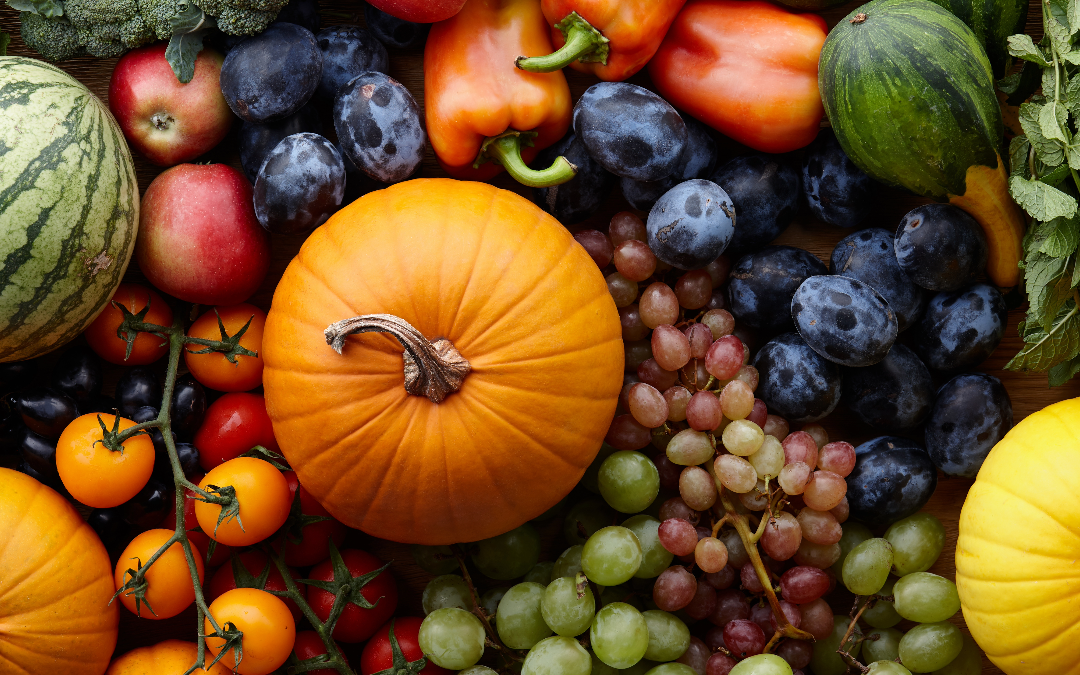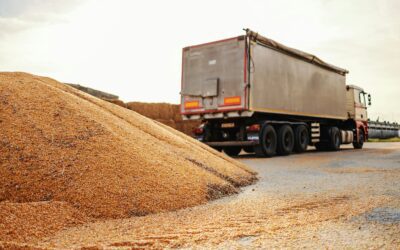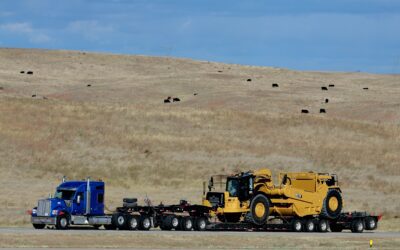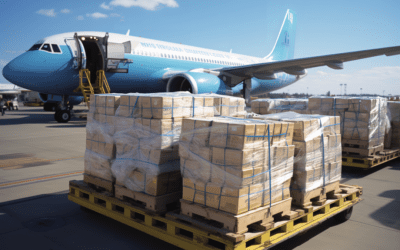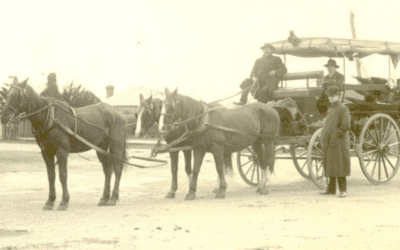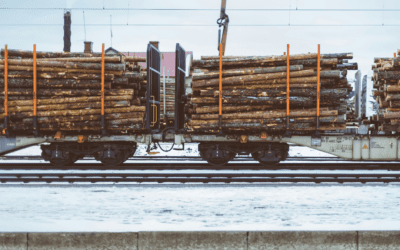Fall planting season is a pivotal moment for farmers across the United States. On average, the United States has over 2.05 million farms, and the agricultural industry profits around $183 billion in revenue. While some perceive autumn as a time for pumpkin patches and apple orchards, for farmers, it means much more. This is the Fall Harvest Supply Chain.
Article Overview
The Importance of Fall Harvest
The autumn harvest season accounts for a major part of the 3.3 billion tons of agricultural products that are transported. Setting the stage for a successful harvest season ensures a steady food supply for the upcoming months.
The choice of crops varies by region and climate, but several staples dominate the autumn fields. For example, fall-harvest crops are usually cool-weather crops, which are commonly planted in early spring in cooler regions. Regions play a pivotal role in autumn crops as well and can completely change the produce taste, size, and maturity time.
A Collaborative Effort
While baking a pumpkin pie can be daunting, it’s the result of a much larger collaboration. It’s the culmination of a team effort involving farmers, truck drivers, and other essential workers who plant, harvest, and bake seasonal ingredients. Before distribution, various processes transform these holiday favorites for stores.
- Corn
Corn is a fundamental crop in American agriculture and a common sight during the autumn season. In the US, over 95% of total feed grain production comes from corn. Livestock feed and fuel tanks are just a few of the many productions that use corn. In fact, only about 7% of the US corn crop is used to feed the US.
States like Iowa, Illinois, and Nebraska are renowned for their massive cornfields, forming what’s often called the “Corn Belt.” Iowa is the world’s leader in corn production, producing 2.3 billion bushels of corn in 2020, accounting for 16.19% of the US total. Illinois, Nebraska, and Minnesota follow Iowa, producing 2.1 billion, 1.8 billion, and 1.4 billion bushels of corn. Together, the top four corn-producing states account for over 54% of the country’s total corn production.

Top Players in Corn Production
Corporations like Monsanto (now Bayer) and DuPont Pioneer have been pivotal in the development and distribution of genetically modified corn seeds, enhancing yields and pest resistance. Farmers either store the harvested corn on farms or transport it to processing facilities for further distribution.
- Soybeans
Soybeans are another essential autumn crop and serve as a vital source of protein for both livestock and humans. These beans dominate a third of US farmland and are a significant export commodity. The primary hub for soybean production is in the Midwest, including states like Illinois, Iowa, and Indiana. In 2022, Illinois produced 677.2 million bushels of soybeans and is the number one state producer in the US.
Soybean Production Corporations
Agribusiness giants like Archer Daniels Midland (ADM) and Cargill are key players in soybean processing and distribution. ADM operates more than 270 plants and 420 crop procurement facilities worldwide. In 2018, ADM and Cargill agreed to a joint venture to provide soybean meal and oil for customers in Egypt, launching SoyVen™ officially.
- Pumpkins
As autumn ushers in Halloween and Thanksgiving, pumpkin patches become a popular destination. Many pumpkin patches allow visitors to pick their pumpkins, creating a family-friendly experience.
States such as Illinois and California are known for their pumpkin production, with Illinois leading states by harvesting more than twice as many pumpkins as other states. California, Indiana, Michigan, Texas, and Virginia each harvested around 7,400 acres.
Pumpkin Distribution Methods
After harvesting, pumpkins are shipped in large bulk boxes or in bulk trucks to retailers, roadside stands, and farmers’ markets for sale. While smaller-scale operations dominate the pumpkin industry, supermarkets and retailers, such as Libby’s brand (owned by Nestle), wield a significant influence, capturing nearly 90% of the North American market for canned pumpkins from October to January.
- Apples
Apples in America are one of the many staples of fall. The crop is rich and diverse, from Granny Smith to Honeycrisp, apples are the cornerstone of fall crops. In 2021, the apple crop totaled just over 10.5 billion pounds, with Washington, New York, and Michigan hosting the largest apple orchards.
Apple orchards flourish in states like Washington, New York, and Michigan. Washington is the perfect location for apple production because of its fertile soil and ideal climate. Each state has its own unique climate and weather conditions that thrive for a variety of apples in their respective environments.
Farmers sort, clean, and package apples on-site or at packing facilities. They distribute the apples to various markets, including grocery stores, farmers’ markets, and cider mills. Major grocery chains, including Walmart and Kroger, help distribute apples to consumers nationwide.
- Wheat
Wheat is a staple crop planted in the fall and harvested the following summer. In the US, wheat produce ranks third, behind corn and soybeans, for planted acreage and gross farm receipts. In 2023, US farmers are expected to produce a total of 1.65 billion bushels of wheat.
The Great Plains, known as the “breadbasket of America,” is home to the largest wheat producers, particularly in states like Kansas, Oklahoma, and Nebraska. Harvested wheat goes into silos and then moves to flour mills for processing. Companies such as Archer Daniels Midland (ADM) and Bunge are major players in wheat processing and distribution.
Farm-to-Plate Distribution Overview
The journey from farm to plate involves a complex network of distribution channels and corporations. The transportation of fall crops from farms to distribution centers and consumers requires careful planning and specialized methods. Here are some key players in the distribution process and the primary modes of transportation:
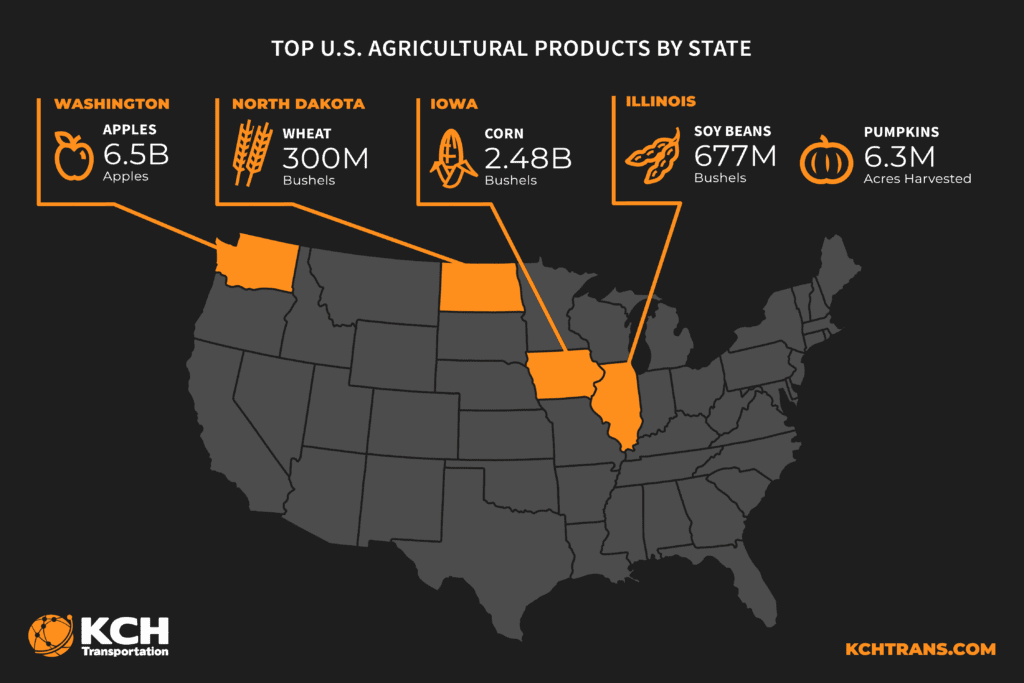
Critical Role of Highways in Agriculture
Highways and trucks are a major portion of all agricultural products. Highways provide first and last-mile transportation connections to other modes, such as rail and ocean vessels. According to the US Department of Agriculture, 80% of domestic agricultural commodities are transported on just 17% of US highways. Macro plastic agricultural bins are certified for food storage and agricultural products. Reusable plastic bulk bins are also an effective choice for shipping bulk agricultural commodities.
Key Bulk Agricultural Transportation
Bulk transport is the main source of transportation for dry agricultural commodities. USDA defines bulk products as grains, oilseeds, pulses, cotton, and other raw agricultural products. Bulk agricultural commodities like grains and oilseeds account for a third of the total value of US agricultural exports but about 70% of the total volume.
- Railroads
Railroads play a crucial role in transporting grains like corn and soybeans over long distances. Railroads account for over a third of US grain export movements. It’s the second most common way to transport fresh foods, falling just behind truckload.
According to the Association of American Railroads, rails typically carry more than 60,000 carloads of food and agricultural products per week. Grain elevators and silos near rail lines are vital to facilitate the efficient loading and unloading of bulk crops each season.
- Ports
For international distribution, crops like soybeans are transported by ships to various global markets. Ports with state-of-the-art facilities are necessary to handle the loading and unloading of bulk shipments.
- Airfreight
While less common for bulk crops, the agriculture industry uses airfreight for high-value, perishable crops like apples or for rapidly transporting specialty products to niche markets. Strict temperature and humidity control are essential for airfreight shipments to maintain product quality.

Key Players in Food Distribution
- Food Processors
Food processing companies play a crucial role in transforming raw agricultural products into food items by using methods that extend the shelf life of food. By employing techniques such as canning, freezing, and drying, food processors facilitate easier transportation and storage, preserving and extending the shelf life of food.
Food processing companies like Archer Daniels Midland, Cargill, and Bunge Limited are instrumental in turning raw crops like soybeans and wheat into various food products. These corporations operate processing plants that transform crops into oils, flour, and other food products. Bunge Limited also produces sugar and ethanol from sugarcane.
- Grocery Store Chains
Major grocery store chains like Walmart, Kroger, and Safeway is central to the distribution of fall crops to consumers. Combined, these stores have a total of 14,514 retail stores. These chains source products from a variety of suppliers, including local farms and larger agribusinesses.
- Amazon Fresh
Amazon dominates the eCommerce market with a 40% market share. E-commerce giant Amazon has entered the grocery industry with Amazon Fresh, offering a convenient way for consumers to access a wide range of fresh produce, including fall crops.
- Farmers’ Market
Farmers’ markets provide a direct link between farmers and consumers. They are an essential outlet for small-scale growers and artisanal producers. The USDA estimates that local food sales from farmers’ markets have grown from about $5 billion to $11.7 billion in 2014.
A Community-Based Food System
During this season as individuals savor the flavors of fall, it’s important to recognize that these seasonal products are the result of a massive effort that spans nationwide. Fall harvest isn’t just a season, but a collaboration that drives American agriculture year after year.
Agricultural Transportation Expertise and Services
KCH Transportation takes pride in providing diverse transportation services to the agriculture industry. Our experienced team members possess extensive knowledge of the unique challenges in transporting agricultural products and work efficiently to ensure effective delivery of crops to the market.

